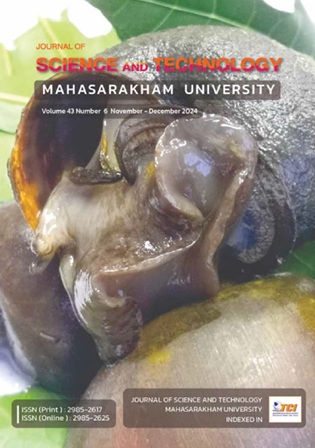Depletion of solar radiation due to particulate matter with diameter of less than 2.5 micron
Main Article Content
Abstract
The aim of this research is to investigate the depletion of solar radiation at the earth’s surface due to particulate matters being smaller than 2.5 µm (PM2.5) under clear sky conditions at a solar monitoring site in Nakhon Pathom province, Thailand (13.82º N, 100.04º E). In this research, PM2.5 was obtained from a low-cost air pollution sensor (AEROBOX), solar radiation was measured by a pyranometer, and cloud cover data was retrieved from a sky camara used in order to classify sky conditions. From the analysis results, monthly average hourly PM2.5 at the site varied between 5 - 160 µg/m3 and the maximum of monthly average hourly solar radiation was 850 W/m2 in March. In addition, the increasing of 1 µg/m3 PM2.5 can affect the decreasing of solar radiation up to 0.58%.
Article Details
References
นิพนธ์ เกตุจ้อย & มรุพงศ์ กอนอยู่. (2555). การศึกษาผลกระทบของฝุ่นบนแผงเซลล์แสงอาทิตย์ต่อการผลิตไฟฟ้า. วารสารวิทยาศาสตร์และเทคโนโลยี มหาวิทยาลัยมหาสารคาม. 32(5), 554-562.
Ahmad, M., Manjantrarat, T., Rattanawongsa, W., Muensri, P., Saenmuangchin, R., Klamchuen, A., Aueviriyavit, S., Sukrak, K., Kangwansupamonkon, W. & Panyametheekul, S. (2022). Chemical Composition, Sources, and Health Risk Assessment of PM2.5
and PM10 in Urban Sites of Bangkok, Thailand, International Journal of Environmental Research and Public Health, 19(21), 14281. https://doi.org/10.3390/ijerph192114281.
Amnuaylojaroen, T., Surapipith, V. & Macatangay, R.C. (2022). Projection of the Near-Future PM2.5 in Northern Peninsular Southeast Asia under RCP8.5. Atmosphere, 13(305), 1-15. https://doi.org/10.3390/atmos13020305
Bahmanbeiglou, K.H. & Movahedi, S. (2017). Identifying sky conditions in Iran from MODIS Terra and Aqua cloud products. Chinese Geographical Science, 27, 800-809, https://doi.org/10.1007/s11769-017-0908-4.
Iqbal, M. (1983). An Introduction to Solar Radiation. Academic Press, New York.
Janjai, S. (2010). A method for estimating direct normal solar irradiation from satellite data for a tropical environment, Solar Energy, 84(9), 1685-1695. https://doi.org/10.1016/j.solener.2010.05.017.
Janjai, S., Pankaew, P. & Laksanaboonsong, J. (2009). A model for calculating hourly global solar radiation from satellite data in the tropics, Applied Energy, 86(9), 1450-1457. https://doi.org/10.1016/j.apenergy.2009.02.005.
Kambezidis, H.D. (2021). The Solar Radiation Climate of Greece. Climate, 9(183), 1-19. https://doi.org/10.3390/cli9120183.
Luo, H., Han, Y., Lu, C. Yang, J. & Wu, Y. (2019). Characteristics of Surface Solar Radiation under Different Air Pollution Conditions over Nanjing, China: Observation and Simulation. Advances in Atmospheric Sciences, 36, 1047-1059. https://doi.org/10.1007/s00376-019-9010-4.
Munyaneza, J., Qaraah, F.A., Jia, Q., Cheng, H., Zhen, H. & Xiu, G. (2022). Seasonal Trends, Profiles, and Exposure Risk of PM2.5-bound Bisphenol Analogs in Ambient Outdoor Air: A Study in Shanghai, China. Aerosol and Air Quality Research, 22, 210324. https://
doi.org/10.4209/aaqr.210324.
Narkwatchara, P., Ratanatamskul, C. & Chandrachai, A. (2020). Effects of particulate matters and climate condition on photovoltaic system efficiency in tropical climate region. Energy Reports, 6, 2577-2586. https://doi.org/10.1016/j.egyr.2020.09.016.
Peng-in, B., Sanitluea, P., Monjatturat, P., Boonkerd, P. & Phosri, A. (2022). Estimating ground-level PM2.5 over Bangkok Metropolitan Region in Thailand using aerosol optical depth retrieved by MODIS. Air Quality, Atmosphere and Health, 15. https://doi.
org/10.1007/s11869-022-01238-4.
Qian, Y., Wang, W.G., Leung, L.R. & Kaiser, D.P. (2007). Variability of solar radiation under cloud-free skies in China: The role of aerosols. Geophysical Research Letters, 34, L12804, https://doi.org/10.1029/2006GL028800.
Southerland, V.A., Brauer, M., Mohegh, A., Hammer, M.S., van Donkelaar, A., Martin, R.V., Apte, J.S. & Anenberg, S.C. (2022). Global urban temporal trends in fine particulate matter (PM2·5) and attributable health burdens: estimates from global datasets, The Lancet Planetary Health, 6(2), e139-e146. https://doi.org/10.1016/S2542-5196(21)00350-8.
Zhou, L., Sun, L., Luo, Y., Xia, X., Huang, L., Liao, Z. & Yan, X. (2023). Air pollutant concentration trends in China: correlations between solar radiation, PM2.5, and O3. Air Quality, Atmosphere and Health, 16, 1721-1735. https://doi.org/10.1007/s11869-023-01368-3.

